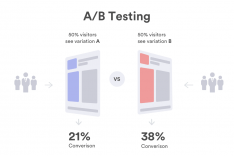Growth Through Innovation Series: Building a Culture of Innovation
Series Overview
This article is the fifth in a series about decoding the black boxes of innovation and incubation. Each article in the series is intended to be a self-contained unit, so please bookmark the first article in this series, so that you can find any piece you wish to see at any time.
Innovation Must Pervade
"Don't tell me you're innovative; show me."
Establishing a true Culture of Innovation requires a company to place a very explicit value on progressive company policies, growth-focused positioning for existing products, and a willingness to invest in employees, experiments, and new initiatives. A Culture of Innovation manifests itself in the form of work environments that are conducive to the types of collaboration that cultivate new ideas. The majority of companies engage in an incredibly silo-driven approach to innovation, locking themselves into policies, procedures, and processes in the interest of efficiency, then holding once a year "hackathons" and touting "open door policies" as a means of bringing about new ideas. In this way, a company tends to position itself to only invest in the kinds of innovative initiatives that have a direct line to ROI, or which explicitly prevent a measurable loss of money. The fact is, however, that it's incredibly difficult to put a monetary value on a true Culture of Innovation, as the returns come in the form of better talent pools, better morale and motivation, greater retention, more focus on progressive change, and a greater feeling of ownership of success.
Establishing a Culture of Collaboration
At the heart of an innovative company is a collaborative machine that leverages the reason to start a company in the first place: the concept that said company has the ability to be greater than the sum of its parts to the benefit of all parties involved. Collaboration leads to employees having more time to focus on doing the things for which they have a greater aptitude. It also creates scenarios in which the best ideas get the attention and development they deserve. Finally, it creates time and environments for employees to consider alternative ways to accomplish goals. In its simplest form, collaboration requires two things: transparency and tools.
Transparency
Organizational transparency comes in two distinct forms: internal and external. Internal organizational transparency refers to the level of information sharing within teams and between employees (horizontal internal transparency), and between employees and leadership (vertical internal transparency). External organizational transparency refers to the extent to which companies share information with people outside of the organization. Both forms are important, but for the sake of collaboration, it is critical for a a company to at least have strong internal transparency.
Vertically speaking, it is common for companies with taller organizational structures to have poor vertical internal transparency simply because information has a tendency to flow upline to decision makers who don't always push information and decision criteria back down the line. This is why flatter organizational structures with fewer layers of management are more common in startup firms, where transparency is more highly valued and collaboration is more prominent. Companies who lock decision making processes at higher levels of management should at least consider publishing their strategic vision internally, and then sharing the connections between operational decisions and that vision widely. Innovation is about empowering your entire organization to make meaningful change, and employees can only pull on the same end of the rope if they know what they're trying to accomplish by doing so.
Horizontal internal transparency represents the bare minimum acceptability level for successful collaboration, and is the form of transparency that receives the most attention and investment. Nearly every company understands the value of teams that work in the same managerial layers being able to collaborate effectively. The extent to which collaboration is encouraged and financially supported can be the difference between achieving division goals and missing them.
Collaboration Tools
The rapid evolution of collaborative work technologies accelerated during the past two years because of COVID causing remote work to become more normalized ('bout time y'all caught up btw). With way more than just GitHub and Google Docs now, people have the ability to manage projects, create prototypes, whiteboard, meet, and perform nearly every software-related job function with secure, robust, cloud-based tools, many of which are even free to use.
Once a company has established transparency internally and equipped teams with the proper tools to facilitate collaboration, the next opportunity to develop collaboration efforts is to determine the best vehicles for engaging external audiences. Being externally transparent accomplishes a number of things, not the least of which is opening the doors to external sources of innovation. With proper strategic sharing, companies can give the appearance that there is no secret sauce that makes success, just the talent and ideas fostered internally. That kind of reputation leads to better talent acquisition, and to being top of mind for more customers looking to work with the best people available.
Establishing a Culture of Thought Leadership
Another value of being externally transparent is the ease with which a company can leverage that reputation to engage in thought leadership. Thought leadership at its core is a buzzword that stands in for "expertise," but implies proactive application thereof. With the amount of money companies invest in acquiring or developing that expertise, it only makes sense to actually demonstrate it as often as possible. Being public about taking progressive approaches to problem-solving, and inviting other people and companies to collaborate on major initiatives or significant ventures only serves to publicly reinforce confidence in your company's ability to attract and retain the best people and build the best products.
Education
Thought leadership is not necessarily pedagogical in nature or intent, but there is a certain predisposition to feeling as though people who engage with real thought leadership end up learning by discovery. Thought-provoking theoretical discussion often fosters a natural inquisitiveness, which can lead to new ideas, greater understanding of perspectives, and more progressive ideology. These are all predictable and reliable outcomes that reinforce the innately educational nature of thought leadership, and any company that wants its own employees to think more critically or become stronger innovators should advocate for thought leadership initiatives.
Publishing Content
Publishing content is the most direct and efficient way to engage in thought leadership. While it is absolutely important to publish within your field of expertise, it can be just as measurably valuable to weigh in on things from a theoretical perspective. The GSE blog is an exceptional example of what it means to take a thought leadership approach to publishing. The content we post here touches on topics that delve into the depth of our competence within the satellite and telematics industry, but also topics like industrial engineering, entrepreneurship, HR, culture, and innovation. We don't limit ourselves to topics within our explicit domains, as long as we have people who can produce content that is well-supported and insightful.
The effects of the GSE blog playing host to such a wide variety of content and topics include the demonstration of GSE's expertise and progressive approach to problem-solving, but also the ability to critically and thoughtfully analyze real world problems in a public discourse. It represents GSE as the kind of company that will tackle tough problems, offer creative solutions, and collaborate with the entire community to get things done. When COVID shut down the entire world and sent people into lockdown, GSE bore a much less significant adjustment due to the fact that our team had already been distributed across the world for years. We then recognized an opportunity to share the expertise we had in remote work and team management with everyone in a series of social media posts and blog articles. To date, we've received dozens of personalized emails from customers and partners who have had to adjust to their teams working remotely, thanking us for sharing our knowledge.
Building Innovation into Products
A company's products are a great place to look for high ROI innovation initiatives. For a culture of innovation to permeate products, it is important for there to be mechanisms in every product that facilitate the growth of that product and signal the opportunities to solve new problems. A company's culture of innovation informs and is informed by their approach to product ideation and growth. Companies with a strong culture of innovation understand the importance of feedback, agility, and experimentation, and take active steps to make each a pillar of successful product design and development.
Feedback
As we all know, consumer tastes, needs, and demands follow trends, but also have a tendency to change with the wind when it comes to new products. Soliciting feedback from products that already exist is a cornerstone of product growth, and something that product managers should always be advocating for with the creation of new products. Product feedback should come both voluntarily and involuntarily from the user(s) of any product whenever possible. For software products, this is perhaps the easiest of all three pillars to achieve, and the least forgivable to forego.
Voluntary feedback is commonplace among companies with an active marketing or sales arm, and is also prevalent in software products that are new or frequently changing. It should never be assumed that customers have the same perspective when a product launches that they had when the product was conceptualized, especially in the software world. It is critically important to test and retest the assumptions and criteria that were used to make product decisions. Validation of the value proposition must continue throughout the growth of the product, and asking customers and users directly whether and how they're getting value from continued use of the product is the most common means of doing so.
Involuntary product feedback is what separates good products from great ones, and innovative organizations from reactive ones. There is no significant barrier to entry for gathering involuntary feedback, especially now that tools like Google Analytics are available free of charge, and youtube has millions of videos that can teach anyone to use these tools effectively. It might be reductive to say so, but the only thing standing in the way of a company and strong involuntary product feedback is poor prioritization or poor understanding of its value. Below are some simple examples of involuntary product feedback that can be extracted from the most basic setup of session data gathering tools.
- Session Time: if it's short, users are either getting exactly what they need right away, or they don't know where to start to try to find it.
- Page Views: provides insights about the standard flow(s) for a particular type of user, and patterns emerge quickly. Pair with session times to understand where they expected to find things vs. where they did, and then apply it to menu navigation optimization.
- Support Pages: keep track of the most commonly viewed support links, and whether or not the user ends the session after viewing it, or goes back to try the thing again.
- Session Time Growth: if users engage for longer or shorter amounts of time as they get acquainted with the product, it can be an indicator of the ease of use or the value they get from logging in. Either way, cross reference with other activity to draw insightful conclusions.
- Time of Day: the most basic analytics involve the when and where of a product's usage, but they can still be incredibly insightful. Are people's sessions very short during "normal" (we're about to address this in the next section) working hours?
While all of this can seem like incredibly advanced backend development, insights like these, along with far more advanced session data can be collected by open source products and services that are available right now, for no money, with minimal software expertise required. Any organization looking for ways to start building their culture of innovation yesterday with minimal investment should be considering the growth infrastructure they can build into their products to help them understand their users and customers more effectively.
Agility
Another pillar of a company with a culture of innovation is agility, which refers to the ability to quickly identify and take advantage of opportunities presented by the market. This is perhaps the most commonly misrepresented facet of a company's product organization, due in large part to a massive disconnect between the perceived definition of agility, the perceived level of agility, the actual definition of agility, and the actual level of agility. To put it plainly, companies often just don't know what it actually means to be agile.
A large part of this misalignment is likely due to the use of the term agility to refer to agile software development methods. An entirely separate can of worms, agile software development methods are likewise very commonly touted by companies who couldn't be further from agile in their practices, and the number of companies who confuse being agile with being agile with using agile with using agile and with being agile is substantial. For the purposes of this article, agility refers to some of the following ideas, which do, in some cases, cross over with Atlassian's agile methodologies and practices.
- Annual SIRB and CAPEX: having annual strategic investment reviews and capital expenditure allocation meetings is not very conducive to agility, as it only provides one opportunity to change course every 12 months. By then, entire business opportunities may well have been consumed by companies who are more agile, or by companies whose fiscal year is better timed to take advantage. Consider more frequent investment reviews as an alternative. Invest in iterative work instead of final versions.
- Differentiate the definition of "finished": when developing new products with agility in mind, understand and embrace the idea of a truly minimum viable product that can be tested, validated, and iterated into a minimum sellable product, and then further iterated into a product that can be sold at the ideal price point.
- Hire more "doers" and less managers: internal bottlenecks are a death knell for a company's agility. It's exceptionally rare for a new product to not be developed and released because of too few managers, but it is exceedingly common for companies to miss opportunities or suffer greater opportunity costs because they don't have enough designers, engineers, or development resources.
- Stop having meetings: meetings are the least productive business practice a team can spend time on in the 21st century. A relic of a business world dominated by silos of information, meetings used to be necessary to make sure teams were communicating clearly because there was no better way to move information from person to person and clarify nuance. With the tools available to teams in 2021, it takes a special cause to justify packing 6+ people into a one hour session at an average cost of $50/hour/person. Agility also means spending less time on each project to open the door to more of them, and time wasted with meetings cuts into that agility.
Agility also requires companies to be able to quickly pick up new projects and deprioritize others. That requires a validation, design, and development process that can be abbreviated as much as possible. Product viability analysis shouldn't take more than two weeks (maybe a month for new products with big price tags) because a company with a proper culture of innovation will have been spending weeks, months, and years documenting trends and opportunities. Design and Discovery phases should last less than a quarter for new products, and less than two weeks for mature products. Development sprints are commonly set to a week or two, but truly agile teams and companies can push code daily. Iterative development means understanding that concept to launch of a testable product shouldn't take more than six months, and also shouldn't require all six months to occur in direct succession. Agility on this scale is absolutely attainable, even for large companies, as long as there is a culture of innovation to support it.
Experimentation
As mentioned above, iterative product development is a key component of Agility, and a large part of effectively iterating is being able to run experiments in a product setting. This means hiring product managers and leadership teams who set the expectation of testing, validating, and iterating products by default. Hire people who have the ability to define a testable product solution, set up an experiment to validate assumptions and expectation, and then make data-driven decisions about how to move forward. Talented product managers are people who think like entrepreneurs, and operate like scientists. For a culture of innovation to be successful, that particular role must be filled with people who understand the value of continuous iteration backed by strong data.
A/B Testing
The most popular and prolific form of product validation experimentation is the use of A/B testing. A/B tests are simple experiments that deliver one experience to one segment of a product's user base, and an experimental experience to another segment of the user base. The purpose of A/B tests is to see if a particular interface or experience will have a desired outcome, and the data they bring back informs the best way forward for the product. Tests like these are commonplace in both mature products and new products for companies that have a healthy culture of innovation.
Embracing Change
By definition, innovation necessitates change. Companies vary greatly in their levels of change tolerance, but at the heart of every innovative company is a progressive approach to at least one of the two major determinants of adaptability. First and foremost, companies building a culture of innovation must embrace technological changes, especially in a business world defined by exponential growth of productivity technologies. To complete the culture of innovation, companies must also embrace changes to the way in which people work and to the expectations of employees.
Technology
Embracing technological change requires more than just buying the latest hardware and using collaborative software tools and .io products. Embracing technological change means having a firm grasp of how technology is being used by customers, keeping a finger on the pulse of what's possible within a particular industry, and rather than using that information to develop strategies for overcoming those changes, using that information to develop products that leverage those changes. While that seems incredibly intuitive, a tragically large number of companies will actually fall into the trap of doubling down on legacy products in the interest of short term gains, then take a reactionary approach to developing new products or acquiring startups when their competitors bring more to the table.
Work and HR
When it comes to HR, it seems the only constant is change as generational shifts and democratization of talent worldwide has the landscape of talent attraction and retention in a state of constant flux. Job seekers are looking anywhere instead of limiting searches to those companies within their geographical confines. Not only is relocation easier and more prevalent for the most nomadic generation in history (Millennials), the popularization of remote work for nearly every job function has made the recruiting game an absolute nightmare for companies stuck in the past. This topic is one that was addressed rather thoroughly in part 4 of this series, and it is a very integral part of establishing a culture of innovation.
Millennials make up the largest percentage of the work force in the United States, and the world is already experiencing the effects of the radically different approach to work/life balance exhibited by this group. The reason things are changing so rapidly is because Millennials by nature are far more willing to embrace change than any generation before them, as their entire formative existence was defined by the transition from analog to digital. Millennials understand change because (we) have always been defined by it, which makes (us) perfect agents to establish cultures of innovation within any company. The ways in which Millennials are leaving a mark on HR norms should be seen as the tip of the iceberg for a culture of innovation. Companies who don't wish to be left behind need to quickly embrace the following.
- Remote work is here to stay
- Flexible work hours are required
- The 40-hour workweek is obsolete
- Benefits need to be on par with developed nations
- Family leave is required
- Diversity is our greatest asset
- Dress codes are draconian and elitist
- There is always a better way to do it
- Social impact matters more than profit
Wrapping Up
Each article in this series is a self contained unit that is intended to help companies of any size become better innovators and cultivate more innovative teams and work environments. If we can provide any additional clarity or assistance with any of the content you find in these articles, please reach out any time and reference the Growth Through Innovation Series.






